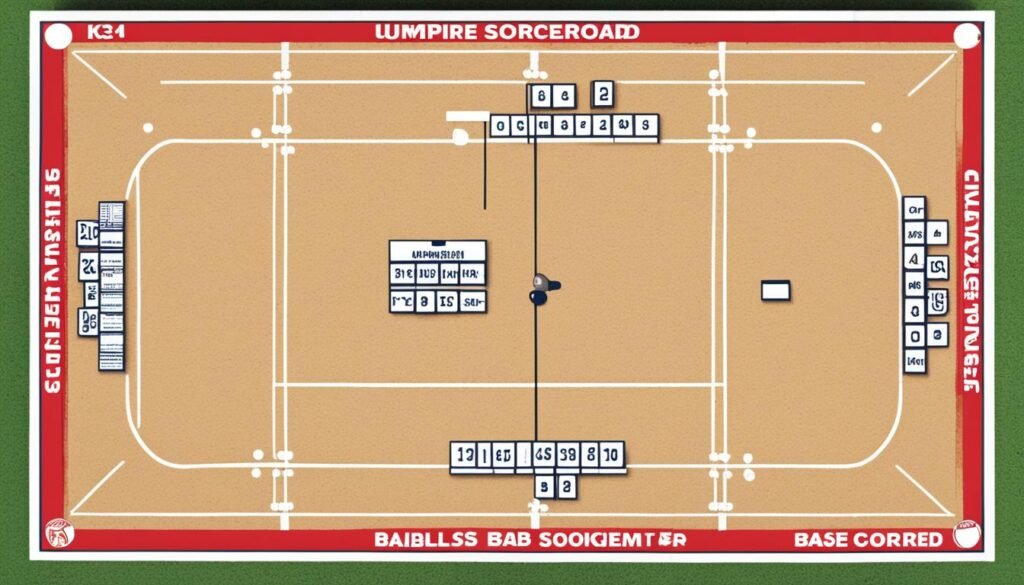In baseball, the umpire scorecard is key to keeping the game fair. It’s not just a record of what happened during the game. It also helps check how well umpires did their job. By using scorecards, leagues and teams can see how officials are doing. This makes sure the game is played right.
Over time, scorecards have changed with new technology. This has made checking umpires’ work more precise. Scorecards are now vital for fairness and making sure everyone plays by the rules.
Key Takeaways
- The umpire scorecard is vital for accurate game evaluation.
- This official scoring tool aids in assessing officiating performance.
- Technological advancements have influenced the evolution of scorecards.
- Consistent use of scorecards enhances the integrity of baseball.
- Historical context underscores the importance of umpire scorecards.
The Importance of Umpire Scorecards in Baseball
Umpire scorecards are key to building transparency and trust in baseball. They record every decision, making umpire actions clear. This shows how vital umpiring is for the game’s integrity.
Scorecards help teams, coaches, and fans understand what happened in the game. They log every call, making umpires accountable. This helps keep the game fair.
Using scorecard feedback helps umpires get better. They can learn from these records in training. This leads to better decisions in future games. It shows how important umpiring is with these scorecards.
Reading and following digital service terms keeps everyone in baseball informed. Scorecards make umpires responsible and help them grow in their careers.
How Umpire Scorecards Enhance Game Accuracy
Umpire scorecards are key to making games more accurate. They keep track of every call during a game. This helps umpires see where they can get better over time.
By looking at the data, umpires can spot common mistakes. This leads to better training to tackle those issues. It’s a way to improve how umpires do their job.
Keeping track of how often and accurately calls are made helps umpires and players get better. As umpires get more skilled, games become more accurate. Technology is helping umpires get even better at spotting different pitches.
Tools like the umpire scorecard show how important data is in making good calls. This method helps umpires grow and makes the game better for everyone.
Understanding the Components of an Umpire Scorecard
Umpire scorecards are key in baseball. They are the official way to keep track of the game. They help umpires, coaches, and players understand the game’s flow and decisions.
These scorecards have important parts:
- Inning: Shows which inning we’re in, helping umpires know the game’s state.
- Batter: Tells us who’s batting, so umpires can watch their performance.
- Pitch Count: Keeps track of how many pitches have been thrown. This helps umpires and pitchers make decisions.
- Balls and Strikes: Counts the balls and strikes for each batter. This makes calling the game easier.
- Specific Calls: Records big decisions like safe, out, strike, and ball. This is important for umpires to be accountable.
Each part of the scorecard has a special job. It helps umpires and coaches check how well everyone is doing. By understanding these parts, everyone can talk better about the game and how players are doing. This makes the sport clearer for everyone.

| Component | Description |
|---|---|
| Inning | Current inning of the game to track progression. |
| Batter | Identifies the player currently at the plate. |
| Pitch Count | Total number of pitches thrown to gauge pitcher workload. |
| Balls and Strikes | Counts of balls and strikes for accurate calls. |
| Specific Calls | Details major decisions made during the game. |
Types of Umpire Scorecards Used in Baseball
Understanding the different umpire scorecards used in baseball gives us a peek into how games are managed. Over time, scoring methods have changed, offering umpires more tools to do their job better. Traditional and digital scorecards are the main types, each with its own benefits.
Digital Scorecards vs. Traditional Scorecards
For decades, traditional scorecards have been a key part of the game. They let umpires keep track of the game by hand. Many umpires like them for their simplicity. They have sections for runs, strikes, and player info.
But, digital scorecards are becoming more popular because they’re modern. They let umpires enter data in real-time, without needing pen and paper. This method gives instant feedback and makes sharing results with coaches easier. Digital scorecards often have cool features like:
- Real-time statistics and analytics
- Customizable templates
- Automatic updates on player performance
Features of Scoring Apps for Umpires
Scoring apps for umpires have changed how games are managed. These apps mix the trustworthiness of traditional scorecards with digital tech for a smooth experience. Scoring apps have cool features like:
| Feature | Traditional Scorecards | Digital Scorecards |
|---|---|---|
| Ease of Use | Manual tracking, requires basic writing skills | User-friendly with intuitive interfaces |
| Data Tracking | Limited data collection, primarily manual | Comprehensive data tracking with analytics |
| Feedback and Updates | Delayed feedback, requires time to calculate | Instant feedback, updates in real-time |
| Publishing Results | Printed distribution, manual sharing | Instant sharing via the cloud or app notifications |
Choosing between traditional and digital scorecards depends on what the umpire prefers and the game’s needs. Using scoring apps can make umpire work more accurate and efficient.
Using Umpire Scorecards for Player Evaluation
Umpire scorecards are key in evaluating players. They help coaches and teams see how players do under pressure. By looking at the data, they can spot strengths and areas to work on during games.
Analyzing Performance Metrics via Scorecards
Scorecards give a lot of info for analyzing performance. They track things like strike and ball calls, and how well players make decisions. Coaches use this info to see how players do in tough situations.
This helps them make training plans that fit each player better. It makes the team perform better overall.
The Role of Umpire Software in Performance Review
Umpire software makes reviewing performance easier. It helps collect and understand data from scorecards better. Coaches get clear insights on trends and areas where players need work.
This tech helps create training plans that focus on each player’s strengths and weaknesses. It makes improving team performance more effective.
Integrating Live Score Updates with Umpire Scorecards
The mix of live score updates and umpire scorecards is changing baseball. Fans and players get real-time insights, making the game more exciting. Updates keep everyone in the loop, making communication clear and transparent.
Teams can track the game’s flow with this tech. Coaches get key info, and players see how they’re doing. This helps with making smart moves during the game.
It also helps umpires by giving them data to check on the fly. This leads to better decisions and a fairer game. Fans love getting updates, turning the game into a thrilling event.

Using these techs makes baseball more fun. Teams are now seeing the benefits. For more on how this changes the game, check out the full overview here.
| Feature | Live Score Updates | Umpire Scorecard |
|---|---|---|
| Real-Time Accessibility | Yes | No |
| Player Performance Metrics | Yes | Reported |
| Enhanced Engagement | High | Medium |
| Decision Support for Umpires | Indirect | Direct |
Umpire Scorecard and Match Official Accountability
Umpire scorecards are key in making umpires accountable. They record decisions and game outcomes. This makes it easier to review performance and spot areas for improvement.
This system also affects players, coaches, and fans. It shapes how they see an umpire’s trustworthiness. When umpires are accountable, trust in them grows. Making consistent decisions is crucial for their credibility.
- Enhanced measurement: Scorecards track umpire performance accurately.
- Post-game evaluations: Teams can review and talk about official decisions with the evidence.
- Community trust: Reliable officiating builds stronger ties between umpires and the baseball world.
Adding these accountability steps helps umpires keep up a high standard. This is good for the sport’s integrity.
Common Challenges in Maintaining Umpire Scorecards
Keeping umpire scorecards accurate is tough. Umpires often make errors in data entry, leading to big mistakes. They have to write down info fast in stressful situations, which can cause mistakes.
Umpires see things differently, making it hard to agree on calls. Their past experiences and views affect how they judge plays. This can lead to disagreements with players, coaches, and fans.
Technology can also cause problems with digital scorecards. Errors or mistakes by users can mess up the data. It’s important for umpires to learn how to use these systems well.
Umpires face a lot of pressure during games, which can affect their decisions. Understanding these issues helps in making better training and tech solutions. This can improve how umpires do their job.
Conclusion
The umpire scorecard is key in baseball officiating. It helps make the game more accurate and fair. It also makes umpires more accountable and helps improve the sport overall.
Technology is changing how umpires work. New tools and apps help make better decisions with data. This change promises a bright future for baseball, with more accurate and fair games.
As umpire scorecards and technology grow, they will affect players and fans. The baseball world is adopting these changes. This means we can expect better officiating, making the game more enjoyable for everyone.
